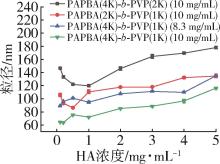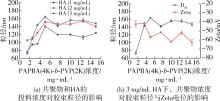京ICP备13020181号-2
© 《China Plastics》
© 《China Plastics》

China Plastics ›› 2024, Vol. 38 ›› Issue (7): 25-31.DOI: 10.19491/j.issn.1001-9278.2024.07.005
• Materials and Properties • Previous Articles Next Articles
LIU Chaofan( ), LIAO Shenglong, ZHONG Shuying, LIN Ying(
), LIAO Shenglong, ZHONG Shuying, LIN Ying( )
)
Received:2023-11-21
Online:2024-07-26
Published:2024-07-24
CLC Number:
LIU Chaofan, LIAO Shenglong, ZHONG Shuying, LIN Ying. Synthesis and properties of responsive hyaluronic acid micelles[J]. China Plastics, 2024, 38(7): 25-31.
Add to citation manager EndNote|Ris|BibTeX
URL: https://www.plaschina.com.cn/EN/10.19491/j.issn.1001-9278.2024.07.005




| 1 | Chaudhuri A, Ramesh K, Kumar D N, et al. Polymeric micelles: a novel drug delivery system for the treatment of breast cancer[J]. Journal of Drug Delivery Science and Technology, 2022, 77: 103886. |
| 2 | Yan J Q, Shan C, Zhang Z R, et al. Autophagy⁃induced intracellular signaling fractional nano⁃drug system for synergistic anti⁃tumor therapy[J]. Journal of Colloid and Interface Science, 2023, 645: 986⁃996. |
| 3 | Wu X Y, Ru Y, Bai Y, et al. PBA composites and their derivatives in energy and environmental applications[J]. Coordination Chemistry Reviews, 2022, 451: 214260. |
| 4 | Çiftçi H, Tamer U. Electrochemical determination of iodide by poly(3⁃aminophenylboronic acid) film electrode at moderately low pH ranges[J]. Analytica Chimica Acta, 2011, 687(2): 137⁃140. |
| 5 | Jiang S L, Xia L. Bioinspired high⁃performance bilayer, pH⁃responsive hydrogel with superior adhesive property[J]. Polymers, 2022, 14(20): 4 425. |
| 6 | Chen W Z, Zhen X, Wu W, et al. Responsive boron biomaterials and their biomedical applications[J]. Science China⁃Chemistry, 2020, 63(5): 648⁃664. |
| 7 | Wang Y X, Fan Y T, Zhang M H, et al. Glycopolypeptide nanocarriers based on dynamic covalent bonds for glucose dual⁃responsiveness and self⁃regulated release of insulin in diabetic rats[J]. Biomacromolecules, 2020, 21(4): 1 507⁃1 515. |
| 8 | Liu B, Song Q S, Wang Z R, et al. Multi stimuli⁃responsive HPC⁃PAA/Eu(AA)3Phen complex nanogels and their decoration with 3⁃APBA for detecting glucose[J]. Journal of Applied Polymer Science, 2021, 138(19): 50368. |
| 9 | Zeng Y, Zhu C Y, Tao L. Stimuli⁃responsive multifunctional phenylboronic acid polymers via multicomponent reactions: from synthesis to application[J]. Macromolecular Rapid Communications, 2021, 42(18): 2100022. |
| 10 | Hu Q, Hu S H, Li S Q, et al. Boronate affinity⁃based electrochemical aptasensor for point⁃of⁃care glycoprotein detection[J]. Analytical Chemistry, 2022, 94(28): 10 206⁃10 212. |
| 11 | Miki R. Structural transitions of micellar systems in response to diol compounds accompanied by changes in viscoelastic properties to yield novel functional materials[J]. Yakugaku Zasshi⁃Journal of the Pharmaceutical Society of Japan, 2023, 143(7): 559⁃563. |
| 12 | Manesh K M, Santhosh P, Gopalan A, et al. Electrospun poly(vinylidene fluoride)/poly(aminophenylboronic acid) composite nanofibrous membrane as a novel glucose sensor[J]. Analytical biochemistry, 2007, 360(2): 189⁃195. |
| 13 | Zhou S Y, Min X, Dou H J, et al. Facile fabrication of dextran⁃based fluorescent nanogels as potential glucose sensors[J]. Chemical Communications, 2013, 49(82): 9 473⁃9 475. |
| 14 | Guo Q Q, Zhang X G. Synthesized of glucose⁃responsive nanogels labeled with fluorescence molecule based on phenylboronic acid by RAFT polymerization[J]. Journal of Biomaterials Science⁃Polymer Edition, 2019, 30(10): 815⁃831. |
| 15 | 伏金平. 肿瘤微环境敏感的纳米显像治疗剂的构建及性能研究[D].兰州:西北师范大学, 2021. |
| 16 | Ha H J, Kang D W, Kim H M, et al. Discovery of an orally bioavailable benzofuran analogue that serves as a β⁃amyloid aggregation inhibitor for the potential treatment of alzheimer's disease[J]. Journal of Medicinal Chemistry, 2018, 61(1): 396⁃402. |
| 17 | Yang Y, Jin Y J, Jia X, et al. Supramolecular hyaluronic assembly with aggregation⁃induced emission mediated in two stages for targeting cell imaging[J]. ACS Medicinal Chemistry Letters, 2020, 11(4): 451⁃456. |
| 18 | Sheng Z H, Guo B, Hu D H, et al. Bright aggregation⁃induced⁃emission dots for targeted synergetic NIR⁃II fluorescence and NIR⁃I photoacoustic imaging of orthotopic brain tumors[J]. Advanced Materials, 2018, 30(29): 1870214. |
| 19 | Guan X L, Wang L, Liu M N, et al. A versatile synthetic approach to tunable dual⁃emissive Pdots with very small⁃size based on amphiphilic block copolymers for cell imaging[J]. Materials Chemistry Frontiers, 2021, 5(1): 355⁃367. |
| 20 | Xu Z J, Liu G T, Liu P, et al. Hyaluronic acid⁃based glucose⁃responsive antioxidant hydrogel platform for enhanced diabetic wound repair[J]. Acta Biomaterialia, 2022, 147: 147⁃157. |
| 21 | Guo Q Q, Wu Z M, Zhang X G, et al. Phenylboronate⁃diol crosslinked glycopolymeric nanocarriers for insulin delivery at physiological pH[J]. Soft Matter, 2014, 10(6): 911⁃920. |
| 22 | 杨贤鹏. 丙烯酰胺⁃丙烯酰胺苯硼酸基水凝胶的制备及其性能研究[D].杭州:浙江大学, 2017. |
| [1] | YU Jiabin, WANG Fei, SHI Wentian, JIANG Yating. Research progress in intelligent manufacture of molds [J]. China Plastics, 2024, 38(7): 100-105. |
| [2] | ZHAO Liping, ZHANG Xiaojuan, PENG Xinhua. Paper shredder plastic parts shell large injection mold design [J]. China Plastics, 2024, 38(7): 106-111. |
| [3] | GAO Zhenqiang, WANG Fei, BAI Yanjun. Flexible surface myoelectric electrodes based on fiber skeleton reinforcement [J]. China Plastics, 2024, 38(7): 68-73. |
| [4] | LIU Baoying, YANG Chenguang, ZHAO Meng, LI Qingzheng, WANG Lei, ZHAI Hua. Experimental study on waste plastic bottles sorting driven excited by dual light paths of visible and infrared light [J]. China Plastics, 2024, 38(6): 111-116. |
| [5] | YE Weiwen, CHEN Zhensen, JIANG Bingchun, WU Guangming. Design of die for double shrinkage water chamber of straight pipe in automotive heat⁃exchange system [J]. China Plastics, 2024, 38(6): 117-124. |
| [6] | CAO Shuai, JIANG Tao, LIU Xiong, WANG Ying, LI Wenge, WU Xinfeng. Research progress in preparation of thermal conductive composites with MXene [J]. China Plastics, 2024, 38(6): 139-144. |
| [7] | ZHOU Ziyi, WANG Yangyang, SUN Tao, JIANG Wei, DONG Tungalag, YUN Xunyan. Properties and applications of poly(butylene adipate⁃co⁃terephthalate)⁃based self⁃regulating gas film [J]. China Plastics, 2024, 38(6): 31-38. |
| [8] | FAN Wenxuan, XU Shuangping, JIA Hongge, ZHANG mingyu, QU Yanqing. Preparation of rigid⁃group⁃bridged polysiloxanes/ethylcellulose mixed membranes for CO2 separation [J]. China Plastics, 2024, 38(6): 51-59. |
| [9] | JI Yaru, LI Ruili, ZHAI Yongyi, ZHANG Shibo. Adsorption and removal of organochloride from plastic oil by MOF⁃808⁃modified material [J]. China Plastics, 2024, 38(6): 82-89. |
| [10] | YIN Dashuai, ZHAO Yongqiang, HEI Ganggang, LI Zhibin. Optimization of injection⁃molding process of screw rotor based on response surface method [J]. China Plastics, 2024, 38(6): 90-97. |
| [11] | LIN Gaoming, ZHANG Guohui, ZONG Huceng, WANG Chongyang, HE Youfeng, WANG Suwei. Simulation and optimization of key component structure of vertical spiral extrusion filling equipment for polymer⁃based high⁃viscous slurry [J]. China Plastics, 2024, 38(5): 107-112. |
| [12] | WU Ruonan, SHI Wenzhao, LU Shaofeng, LIU Jinshu, DONG Jiankun, CUI Junjie, ZHANG Ling. Research progress in adsorption and separation of dyeing wastewater by β⁃cyclodextrin polymer [J]. China Plastics, 2024, 38(5): 120-128. |
| [13] | CHEN Xiaoqing, LIANG Jiahao, XIE Wenyu, SHAO Weiming, WANG Ruzhen, FU Wen, CAI Yebin. Preparation of electrospun photothermal conversion nanofibers and their application in solar⁃driven interface evaporation [J]. China Plastics, 2024, 38(5): 129-136. |
| [14] | ZHANG Yi, HUANG Yating, WEI Yongbao, TANG Wei, QIAN Lijun. Study on pyrolysis mechanism of intumescent flame⁃retardant system based on reaction force field [J]. China Plastics, 2024, 38(5): 66-72. |
| [15] | YANG Chaoyong, GUO Jinqiang, WANG Fuyu, ZHANG Yuxia. Effect of extrusion blowing process on microstructure and properties of PBAT/PLA blend [J]. China Plastics, 2024, 38(5): 82-87. |
| Viewed | ||||||
|
Full text |
|
|||||
|
Abstract |
|
|||||